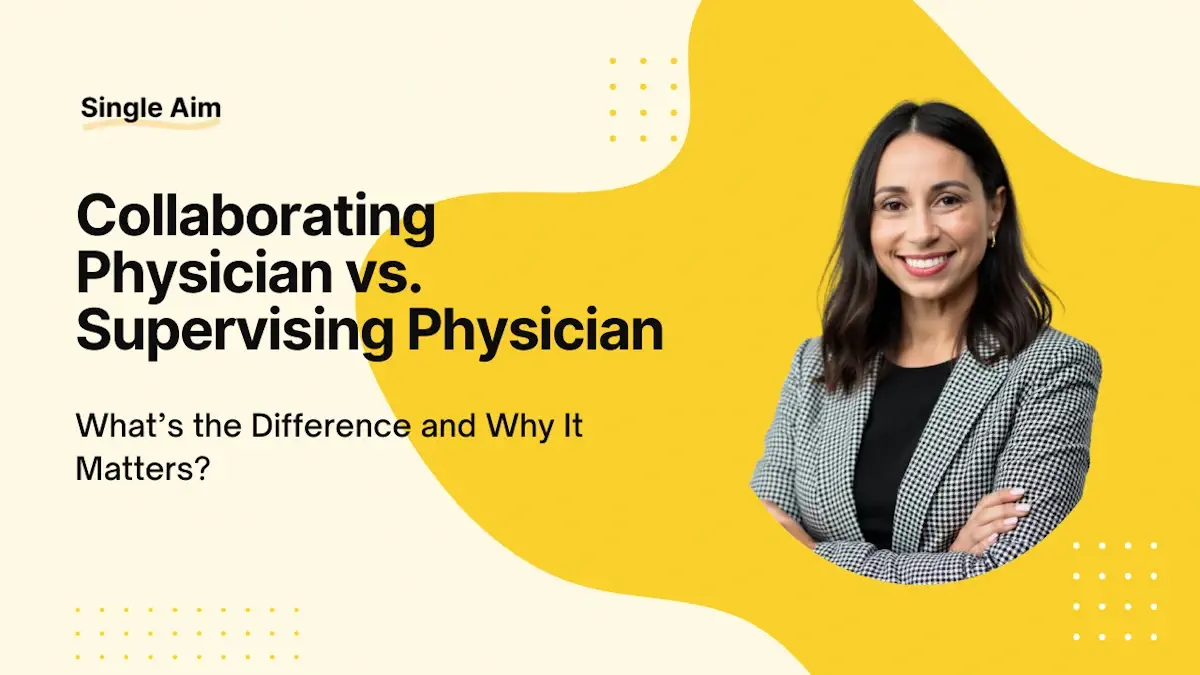Collaborating Physician vs. Supervising Physician: What’s the Difference and Why It Matters?

The terms collaborating physician and supervising physician are often used interchangeably, but they have distinct meanings based on state regulations, provider type (NP vs. PA), and evolving healthcare laws. In some states, the shift from “supervision” to “collaboration” reflects a broader movement toward increased autonomy for nurse practitioners (NPs) and physician assistants (PAs).
This article breaks down the key differences between the two roles and how it impacts NPs and PAs in the United States.
The History of “Collaboration” vs. “Supervision”
Historically, physicians were required to “supervise” all non-physician practitioners, a term that implied direct oversight and decision-making authority. However, over the last two decades, many states have shifted toward a collaboration model, particularly for nurse practitioners.
- Supervision originated in laws that defined physician-led teams, requiring a physician to have the final say on diagnoses, treatments, and prescriptions.
- Collaboration emerged as a more flexible term in the 1990s and 2000s, as states recognized the increasing role of NPs and PAs in providing primary and specialty care.
Today, many states are replacing supervision laws with collaboration models, giving NPs and some PAs greater autonomy, particularly in rural and underserved areas where physician shortages are common.
What Is a Collaborating Physician?
A collaborating physician is a licensed medical doctor (MD/DO) who enters into an agreement with an advanced practice provider (APP)—usually an NP or PA—to consult, review cases, and ensure state regulatory compliance.
Key Features of a Collaborating Physician:
✅ No Direct Oversight Required: Physicians do not have to be physically present but must be available for consultation.
✅ Varies by State: Some states mandate formal Collaborative Practice Agreements (CPA), while others allow informal collaboration.
✅ Primarily for NPs & Some PAs: Most commonly required for NPs in restricted-practice states and PAs in transitioning states.
✅ Chart Review Requirements Vary: Some states require a set percentage of charts to be reviewed, while others leave it to the provider’s discretion.
How Collaboration Varies by State
- Texas – Requires a Prescriptive Authority Agreement (PAA) for NPs and PAs, with specific chart review requirements.
- Florida – NPs need a supervising physician unless they qualify for an autonomous practice license.
- Ohio – NPs must have a Standard Care Agreement (SCA) with a physician, but PAs operate under Supervision Agreements.
- California – Under AB 890, experienced NPs can practice independently without a physician. PAs still require formal supervision.
What Is a Supervising Physician?
A supervising physician has direct oversight responsibilities for mid-level providers, primarily PAs. While some states still use the term for NPs, the shift is increasingly toward collaboration rather than strict supervision.
Key Features of a Supervising Physician
✅ More Direct Oversight: Often required to review charts, approve prescriptions, or provide direct input on clinical care.
✅ May Require On-Site Presence: Some states mandate that the physician be within a certain distance of the PA.
✅ Higher Liability: Supervising physicians assume greater legal responsibility for patient care outcomes.
✅ Mainly Required for PAs: While some states still require NPs to have supervising physicians, the trend is toward collaboration.
How Supervision Varies by State
- California – PAs must have a Supervision Agreement, but the physician does not always need to be on-site.
- Texas – Physicians must define the PA’s scope of practice through a Delegation Agreement.
- Florida – Requires formal written protocols between a PA and supervising physician.
- Ohio – PAs need a Supervision Agreement, but many tasks can be delegated.
Key Differences
Key Differences Between Collaborating and Supervising Physicians

How These Terms Are Often Misused
Because laws vary widely by state, the terms supervising physician and collaborating physician often get confused.
❌ "Supervision means the physician must always be present." – Not always! Some states allow remote supervision.
❌ "All NPs need a supervising physician." – Many states (like California) now allow full practice authority for NPs.
❌ "PAs have the same independence as NPs." – PAs are still generally required to have supervising physicians, though some states allow more independence.
Why This Matters
Why this matters for Physicians, NPs & PAs
Understanding whether a state requires collaboration or supervision can significantly impact:
- Physician hiring and agreements – Do you need to sign a Supervision Agreement or a Collaboration Agreement?
- NP and PA job options – Some states offer greater autonomy, affecting practice opportunities.
- Legal and compliance risks – Failing to follow state-specific terminology and rules can lead to fines, audits, or legal action.
The Shift Toward Collaboration
The national trend is moving toward more independence for NPs and PAs, with supervision requirements gradually being replaced by collaboration agreements.
- NPs: Over 25 states and Washington D.C. now allow full practice authority—meaning no required physician oversight.
- PAs: Some states are transitioning from strict supervision to collaborative practice models, giving PAs more flexibility.
States like California, Washington, and Arizona are leading this movement, while states like Texas, Florida, and Ohio still have stricter regulations.
Compliance & Physician Agreement
Navigating Compliance & Finding the Right Physician Agreement
If you’re a physician looking to collaborate or supervise, or a PA/NP seeking the right partnership, Single Aim makes the process easy.
Why Choose Single Aim?
✅ Directly connect with collaborating and supervising physicians.
✅ Physicians set their own terms and compensation.
✅ Streamlined onboarding to ensure compliance.
✅ Access state-specific resources tailored to your practice.
Take Control of Your Practice
Whether you need a collaborating physician for state compliance or a supervising physician for oversight, Single Aim provides the tools and network to find the right match.
👉 Learn more and sign up at Single Aim Health
Find Collaboration Opportunities
.png)
Find Collaborating Physicians
.png)






